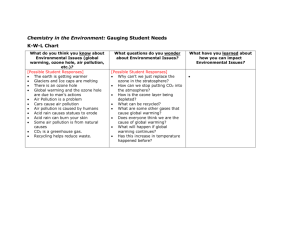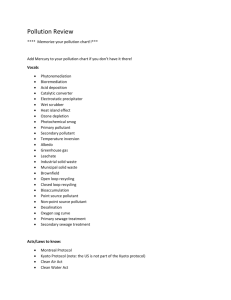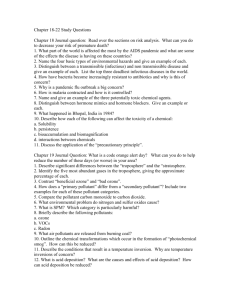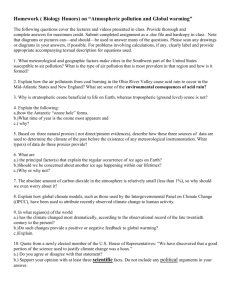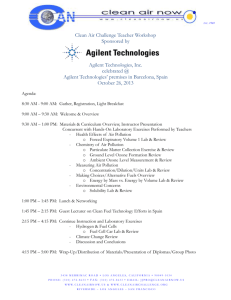Air Pollution Lecture Outline
advertisement
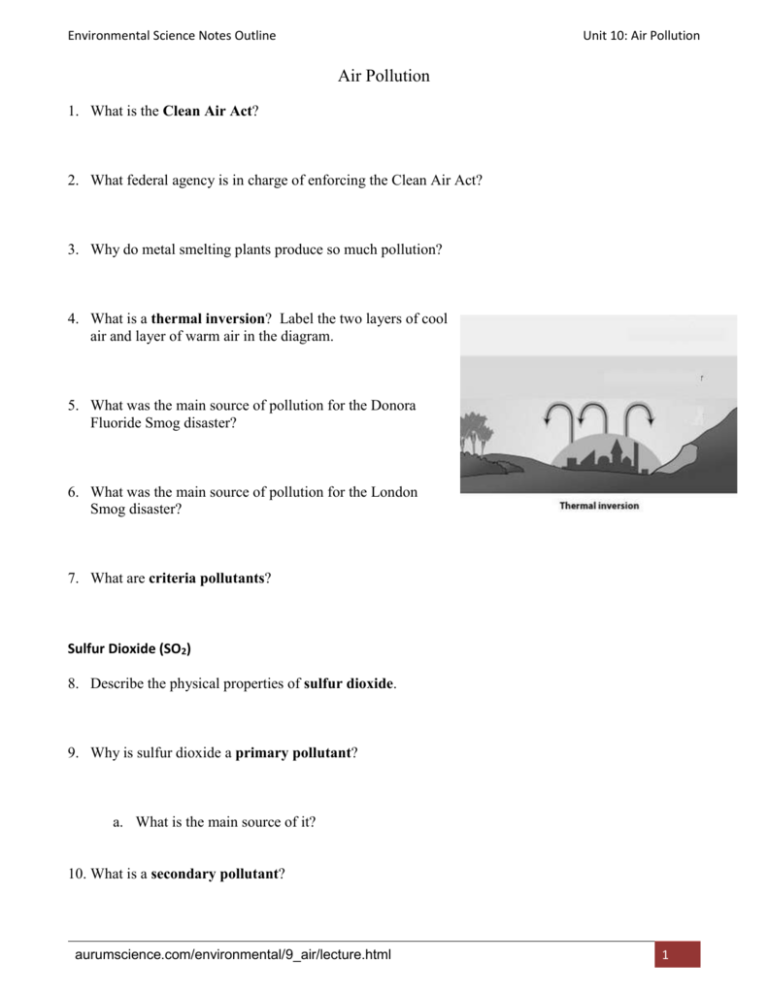
Environmental Science Notes Outline Unit 10: Air Pollution Air Pollution 1. What is the Clean Air Act? 2. What federal agency is in charge of enforcing the Clean Air Act? 3. Why do metal smelting plants produce so much pollution? 4. What is a thermal inversion? Label the two layers of cool air and layer of warm air in the diagram. 5. What was the main source of pollution for the Donora Fluoride Smog disaster? 6. What was the main source of pollution for the London Smog disaster? 7. What are criteria pollutants? Sulfur Dioxide (SO2) 8. Describe the physical properties of sulfur dioxide. 9. Why is sulfur dioxide a primary pollutant? a. What is the main source of it? 10. What is a secondary pollutant? aurumscience.com/environmental/9_air/lecture.html 1 Environmental Science Notes Outline Unit 10: Air Pollution 11. What secondary pollutant does sulfur dioxide form when released into the atmosphere? 12. Name some sources of primary and subsequent secondary pollutants: 13. Name some primary air pollutants. 14. Name some secondary air pollutants. Nitrogen Oxides (NOx) 15. Describe the physical properties of nitrogen oxide. 16. What are the two largest sources of nitrogen oxide? 17. What secondary pollutant does nitrogen oxide form? Carbon Monoxide (CO) 18. Describe the physical properties of carbon monoxide. 19. What is the largest source of carbon monoxide? 20. Why is carbon monoxide so dangerous to human health? Particulates (PM2.5 and PM10) 21. What are particulates? aurumscience.com/environmental/9_air/lecture.html 2 Environmental Science Notes Outline Unit 10: Air Pollution 22. What is the difference between PM2.5 and PM10? 23. What effects do particulates have on human health? Lead (Pb) 24. What is lead? 25. How does lead affect human health? 26. What was the primary source of lead pollution at the time of the passage of the Clean Air Act in 1970? 27. Name some ways that lead poisoning could be prevented: a. b. c. d. e. f. g. aurumscience.com/environmental/9_air/lecture.html 3 Environmental Science Notes Outline Unit 10: Air Pollution 28. Name some ways that lead poisoning could be controlled: a. b. c. d. e. f. g. Ground-Level Ozone (O3) 29. What is ground-level ozone? How is it produced? 30. What are volatile organic compounds? 31. What are ozone action days, and why are they declared? 32. What impact has the Clean Air Act of 1970 had on pollution levels? a. How has it affected human health? Acid Precipitation 33. What pH must rain or snow have to be considered acid precipitation? 34. What two ecological impacts does acid rain have? 35. How does acid rain affect human structures? aurumscience.com/environmental/9_air/lecture.html 4 Environmental Science Notes Outline Unit 10: Air Pollution 36. How have acid precipitation levels changed since the passage of the 1990 Clean Air Act Amendments? 37. List some ways in which acid deposition could be prevented: a. b. c. d. e. f. g. 38. List 2 ways in which acid deposition issues in surface waters could be remedied: a. b. aurumscience.com/environmental/9_air/lecture.html 5 Environmental Science Notes Outline Unit 10: Air Pollution Ozone Layer 39. What does the ozone layer do? 40. Where was a “hole” in the ozone layer discovered? 41. What was the cause of the ozone hole? a. Why was the hole increasing fastest in the September and October? 42. What action did countries signing the Montreal Protocol take to deal with the ozone hole? a. Was the Montreal Protocol successful? b. When is the ozone hole predicted to recover? 43. List some effects of ozone depletion on human health: 44. List some effects of ozone depletion on food and forests: 45. List some effects of ozone depletion on wildlife: 46. List some effects of ozone depletion on air pollution: 47. List an effect of ozone depletion on global warming: aurumscience.com/environmental/9_air/lecture.html 6 Environmental Science Notes Outline Unit 10: Air Pollution 48. Name 4 things YOU can do to reduce overt exposure to dangerous UV radiation: a. b. c. d. Keeping Air Clean 49. What does a scrubber system do? 50. How do electrostatic precipitators work? 51. What pollutants do catalytic converters reduce emissions of in cars? 52. What fuel is often used in place of coal to reduce pollution? aurumscience.com/environmental/9_air/lecture.html 7


